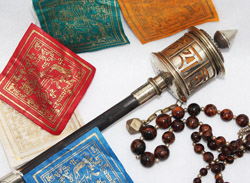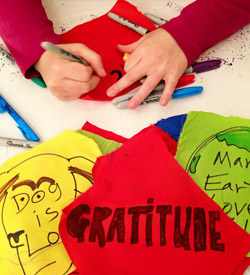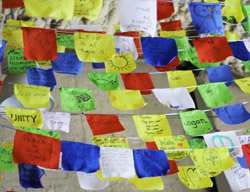
Buddhism, technically-speaking, is not a religion, thanks to the fact that there is no God. The Buddha never claimed to be a deity, he never advocated praying to deities, and he never suggested that such prayers would be answered. Nevertheless, there’s an awful lot of prayer in the Tibetan Buddhist tradition, and many Buddhist rituals look an awful lot like people praying to something. Assisting them in their not-prayer are various prayer devices including wheels, beads, and flags. So what exactly is going on? As with all prayer, I suspect we don’t really know, but as the Christian calendar moves inexorably toward the story of Jesus’ crucifixion and his night in the Garden of Gethsemane, all this Buddhist prayer has given me some food for thought.
Prayer Wheels
Prayer wheels are a bit of a misnomer since they are actually spinning mantras. Welcome to the world of linguistics. The wheels are made by rolling a long sheet of paper around the inside of a cylinder. Running through the center of the cylinder, with the paper rolled around it, is a spindle or pin that allows the entire cylinder to spin. The most common mantra is “om mani padme hum*” which is written over and over again on the coiled paper. Large prayer wheels might contain thousands of copies inside their massive cylinders. The outside is also decorated with an ornate version of the prayer.
The wheels themselves come in all sorts of styles and sizes. Smaller versions include a handle that extends below the cylinder to facilitate spinning. I’ve watched Buddhist teachers spin them for hours while listening to teachings. Larger ones can be spun by simply moving one’s hand across the cylinder. At some monasteries, prayer wheels are placed side by side along sidewalks and courtyard walls. As practitioners circumambulate, they simply brush their hand along the wheels, spinning the entire row, one by one, as they walk by. Lightweight versions can be moved with water, wind, or steam; modern versions can be driven by light; and mechanical versions are powered by electricity. You can even download a digital spinning wheel on your computer, which His Holiness the Dalai Lama has equated with the more traditional versions.
Spinning the wheels is, in many ways, equivalent to repeating the mantra over and over again. In this sense, the more copies of the mantra inside the cylinder, the more spiritually powerful it is. And that’s where the interpretive fun begins. An old metaphor suggests that the Buddha’s teachings are like “turning the wheel of the dharma.” For some, then, these prayer wheels represent a physical manifestation of that idea. Others say the wheels help accumulate merit or replace years of retreat. More on that in a minute.
Prayer Beads
Prayer beads are another tool in the Buddhist prayer shed. Also called malas, they are used to keep count of mantras recited while meditating. In the Tibetan tradition, 108 is a significant number, so many malas contain 108 beads. These beads can be made of all sorts of things – wood, bones, pearls, seeds, metals, or gemstones – and some practitioners match bead composition with their prayer intentions. For example, if the point of the mantra is purification, white beads might be used.
Malas often contain other items on the strand, such as a tassel, interim counters, or a guru bead (honoring the teacher who offered the mantra). Their use is highly similar to the rosary in Christianity, the misbaha in Islam, the japa mala in Hinduism, and the prayer beads used by some Bahá’ís. In all cases, the beads are used to keep track of recitations, whether they be prayers, the name of a deity, the names of God, a mantra, or some other phrase.
Prayer Flags
Finally, we have prayer flags. Prayer flags have become hugely popular in the U.S. At my house, we have a strand hanging on our refrigerator in and amongst all the Christmas photos of friends and family, and my teenaged daughter wants to adorn her bedroom with them. The most common version consists of fabric cut into squares or rectangles and then hung from the top edge along a string. As with any ancient practice, the origins are murky. Inscribed with sutras, they may have been used as banners to spread teachings during travel or conquest. Others say they were used by the devas (benevolent deities) as battle standards in their ongoing strife with the asuras (materialistic deities). The traditional colors – blue, white, red, green, and yellow – represent the five elements – sky/space, air/wind, fire, water, and earth. And most scholars agree that the modern version of the flags was introduced to Tibet around 1000CE.
Of course, with increased popularity comes increased variability. Many, perhaps even most, people have no idea that the five colors represent the five elements or that balance among those five elements rests at the core of Tibetan medicine. Nor is there much concern over the order in which the flags are placed or what is written on them. A few weeks ago, our Jubilee! Church community in Asheville, NC made hundreds of prayer flags – 732 to be exact. They are now hanging in our sanctuary. Of the 700+ flags displayed in our church, not a single one contained a sutra in any traditional sense of that word. Instead, people drew pictures, wrote single words, or offered a short phrase. And we hung them in whatever order we pleased, thankful that we had plenty of volunteers to help with all that stapling.
 |
 |
And therein lies the beauty of prayer. It doesn’t really matter what it’s supposed to look like or how it’s supposed to work. People will use it in whatever way they wish. During my Christian grade school years, I was taught (more than once) that there are four types of prayer. Prayers of adoration praise God, prayers of supplication make a request of God, prayers of intercession make a request on behalf of someone else, and prayers of thanksgiving offer gratitude. It was a fairly comprehensive list and probably covered most things I prayed for at the time, but putting prayer in a box is just about as futile as putting God in a box.
Similar lists exist for Tibetan Buddhist prayer. Although the language is a bit different, spinning prayer wheels and reciting mantras are said to manifest wisdom, remove obstacles, increase compassion, reduce attachment, encourage peacefulness, promote harmony, and speed enlightenment. It’s another fairly comprehensive list that attempts to articulate that which cannot be described.
The bottom line is that no list, regardless of its length or inclusivity, will ever cover what actually happens when any given person prays. Prayer, at its best, is a way for people to rub elbows with the Divine, to sit with the Great Mystery, or to brush against all that is Sacred – even if it’s just for a moment. We can never say for certain what those Garden of Gethsemane prayers meant for Jesus in that time and in that place. Maybe he was supplicating, or maybe he was trying to reduce attachment and increase compassion. In the same sense, it’s quite possible that Buddhist pray-ers are also making requests – either for themselves or someone else – despite the fact that there is no God to listen.
Religions need to let go of the false supposition that prescribed teachings represent the belief systems of everyone gracing the pews and mats. Religions offer only a method, an articulation, or an approach. They represent practices that have worked for others. But most adherents are probably just doing what they want – writing whatever they want on the flags and stapling them to the string in any order that pleases them, so to speak. I suspect both the Buddha and Jesus would be just fine with that.
* The direct translation of the phrase “om mani padme hum” is something like “praise to the jewel in the lotus,” but the meaning is much more complex, incorporating numerous ideals — purity of speech, body, and mind; the goal of enlightenment, compassion, and love; the wisdom to realize that life is both impermanent and empty; and the deep recognition of the oneness of all. (And that still doesn’t really do the phrase justice.)